苏教版小学五年级英语语法.doc
苏教版【五年级】英语语法知识汇总(全)(完美版)
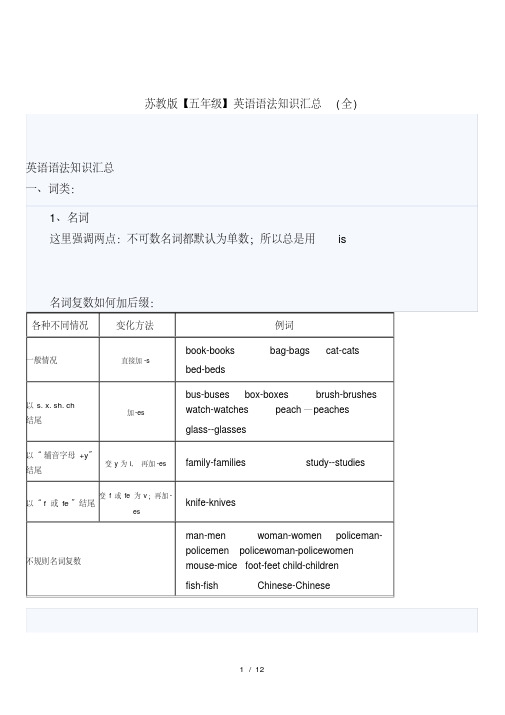
苏教版【五年级】英语语法知识汇总(全)英语语法知识汇总一、词类:1、名词这里强调两点:不可数名词都默认为单数;所以总是用is名词复数如何加后缀:各种不同情况变化方法例词一般情况直接加-s book-books bag-bags cat-cats bed-beds以s. x. sh. ch 结尾加-esbus-buses box-boxes brush-brusheswatch-watches peach—peachesglass--glasses以“辅音字母+y”结尾变y为i, 再加-es family-families study--studies以“f或fe”结尾变f或fe为v;再加-esknife-knives不规则名词复数man-men woman-women policeman-policemen policewoman-policewomen mouse-mice foot-feet child-childrenfish-fish Chinese-Chinese2、人称代词和物主代词人称代词物主代词单数复数单数复数主格宾格主格宾格形容词性形容词性第一人称I(我)me we(我们)us my(我的)our(我们的)第二人称you(你)you you(你们)you your(你的) your(你们的)第三人称he(他)himthey(他/她/它们)themhis(他的)their(他/她/它们的)she(她)her her(她的)it(它)it it(它的)人称代词:有主格和宾格之分.一般动词前用主格;动词后用宾格.3、指示代词4、冠词有a、an、the.a和an的区别:an用于元音音素(一般就是元音字母a、e、i、o、u)前;a用于辅音音素前.二、否定句:be动词(am、is、are)+not、情态动词can+ not、助动词(do、does) + not如何将一个肯定的陈述句改为否定句:1、看句中有无be动词;如有;直接在be动词后+ not.2、看句中有无情态动词;如有;直接在情态动词后+ not.3、如上述二者都没有;就应用助动词+ not.分四个步骤:(1)肯定陈述句中本来是没有助动词的;要加上去;位置在主语(某人或某物)后;动词前.(2)确定助动词用do、does;根据句中动词;动词是原形的助动词就用do;动词是第三人称单数的助动词就用does;(3)在助动词后加not.(4)原句中动词假如发生变化就要恢复成原形.强调一点;有some的要考虑是否要用any.三、一般疑问句.如何将一个肯定的陈述句改为一般疑问句:1、看句中有无be动词;如有;把be动词提到句首即可.2、看句中有无情态动词;如有;把情态动词提到句首即可.3、如上述二者都没有;就应把助动提到句首.分四个步骤:(1)肯定陈述句中本来是没有助动词的;要加上去;位置在主语(某人或某物)后;动词前.I do like you.(2)确定助动词用do还是does;根据句中动词;动词是原形的助动词就用do;动词是第三人称单数的助动词就用doesHe does like you.(3)把助动词后提到句首.Does he like you?(4)原句中动词假如发生变化就要恢复成原形.强调一点;有some的要考虑是否要用any.四、特殊疑问句.表示疑问;有疑问词(在开头);回答有很多种可能.常用疑问词:疑问词意思用法What time 什么时间问具体时间;如几点钟Who 谁问人Whose 谁的问主人Where 在哪里问地点What 什么问东西、事物What colour 什么颜色问颜色How old 多大年纪问年纪How many 多少数量(可数名词)问数量How much 多少钱;多少数量(不可数名词)问多少钱或数量(不可数)五、时态1、一般现在时:表示某动作或者某状态是经常发生的事情,或者是自然规律.?主语+be动词(am, is , are)?主语+动词原形(注意动词要根据主语变三单)(1)一般现在时中的be动词:一般用原形:am is aream用于第一人称单数(I);is用于第三人称单数(he she it和其他人名或称谓;如:Ben his sister等);are用于第二人称单数(you)和所有复数(包括第一人称复数we、第二人称复数you;第三人称复数they和其他复数;如the children 、 his parents等).(2)一般现在时中的动词:第一种情况:主语是第三人称单数(he she it 和其他;如Helen 、her cousin 等);动词后一般加s或es.第二种情况:主语不是第三人称单数;动词都用原形.(4)一般现在时判断依据(如何判断一个句子是一般现在时):△be动词是am、is、are △动词用原形或加s、es△没有时间状语或有usually、often、everyday、sometimes等不是具体的时间2、现在进行时(1)构成形式:Be动词+动词的ing形式这里强调一点;两者缺少其中任何一种都不可以构成现在进行时.(2)现在进行时表示动作正在进行或事情正在发生.(3)有用的依据:一个句子中既有be动词;又有动词;且动词加了ing ←→该句是现在进行时(4)句中往往有now、look、listen等词.动词现在分词的变化见下表:同音词: too---two----to buy---by I---eye four----for there----their right----write sun----son no----knowhere---hear who’s----whose近义词:many----a lot of / lots of large----big desk----table photo---picture lamp----light like----love反义词或对应词:old----new big----smallopen----close black----white here----there完整形式:let’s=let us(让我们) I’d=I wouldcan’t=can not I’m=I am词性变换:one(序数词) first monkey(复数)monkeys skiing(原形)ski is(复数)are families(单数)family make(现在分词)making we are(缩略形式)we’re do(第三人称单数)does have(第三人称单数)hasphoto(复数)photos fat(反义词)thin★做题目时一定要记住:1.can+动词原形2.like+动词ing3.like+名词复数4.play+足球类 play the +乐器类5.how many +名词复数6.would like +to+动词原形7.let's+动词原形8.现在进行时:be(am,is,are)+动词ing9.动词第三人称单数形式英语音标及字母组合对照元音: 1) [i:] 字母组合:ee ea e ie ei eythree tree green sheep meet beef see seekeat tea meat leave lead teacher team mean speak clean pleasehe she mepiece receive ceiling2)[ I ]发音字母 i y e ui u asit picture it is list six mix fix fit pig big build missmyth many twenty happy dictionarydefect decide delicious3) [ ? ] 发音字母 abag hand and ant happy hat map mad bad black back glad flag shall man4) [e] 字母组合 ea e a (ue,u,ie,ai,ei,ay)head bread pleasureelephant electric remember sell shell lesson better bed desk hotel yesmany any5) [ε:] 字母组合ir ur ear er orgirl shirt skirt thirty thirteen third birdturn burn murder nurse turtle Thursday burgerlearn earn earth heardterm her nerd servework worm work world6) [ε] 字母组合 er or ou ar o a e uteacher leader remember player speaker farmer powderdoctor actor mayor author tractordelicious gracious pleasurefamiliar collar dollartogether tomorrow today shallop lesson Washington control polite around account ago elephant manta banana Canada Japan china men listenfamulus Saturday7) [a:] 字母组合 ar acar farm card arm gardenfast class last glass plant aunt calm8) [ ? ] 发音字母 u o ou ooup supper lunch fun gun hunt cup bustrouble rough flourishblood flood9) [?: ]字母组合 al or au our arsmall wall talk tall hall ball call walkshort more lord horse for forty sport door floor storeauthor caught autumnfour mourn court boughtwarm quarrel quarter10) [ ? ] ([?])发音字母 o a ouhot lost lot fox box mop hop loss collar notwant wash watch11) [u:] 字母组合 oo o ufood moon room gloom broom doom goose toothshoe do twotrue truth blue full prude12) [u] 字母组合 oo ou u olook good foot book woodshould couldput full bull pull pushwoman wolf13) [ei] 发音字母 a ay ea ai eyname cake late gate plane Aprilplay say may waygreat breakrain paint plainthey grey14) [ai] 发音字母 i ybike fine find die nine light night highmy try fly eye15) [au] 字母组合 ou owhouse out flour ground account count sound loud around mouse flower down now cow how town16) [εu] 发音字母 o ow oahome cold go no phone host ghostknow low below grow blow show flowboat coat goal17) [ ??] 字母组合oy oiboy toy joyoil soil voice choice18) [iε] 字母组合 eer earbeer deerear nearhere fierce idea19) [ ?? ] ([e?])字母组合ear air erepear bearchair air fairthere where care20) [uε] [au?]字母组合our owerhour tourflower shower。
(word完整版)苏教版五年级语法及练习

五年级语法There be 句型与have, hasThere be 句型与have, has的区别1、there be句型与have(has) 的区别:there be 表示在某地有某物(或人);have(has) 表示某人拥有某物。
There be 句型是客观存在的“有”,表示在某地有某物(或人),是一种存在关系。
eg:There is a book on the desk.Have/has 指的是主观上的“拥有,持有”,表示某人拥有某物,是一种所属关系。
Eg: I have a book.2、在there be 句型中,there 只起到引导作用,并无实际意义。
句中真正主语是谓语动词be后面的名词。
Be动词有人称,数和时态的变化:主语是单数,be 动词用is ; 主语是复数,be 动词用are 。
3.如有几件物品,be 动词根据最近be 动词的那个名词决定(就近原则)。
4、there be 句型的否定句在be 动词后加not , 一般疑问句把be 动词调到句首,肯定回答:Yes, there is/are. 否定回答:No,there is n’t/aren’t.5、some 和any 在there be 句型中的运用:some 用于肯定句,any 用于否定句或疑问句。
6、and 和or 在there be句型中的运用:and 用于肯定句, or 用于否定句或疑问句。
7、针对数量提问的特殊疑问句的基本结构是:How many + 名词复数 + are there + 介词短语?How much + 不可数名词 + is there + 介词短语?8、针对主语提问的特殊疑问句的基本结构是: What’s + 介词短语?练习:Fill in the blank with “have,has”or “there is , there are”1. I________a good father and a good mother.2. ____________a telephone on the desk.3. He_________a tape-recorder.4. _____________a basketball in the playground.5. She__________some dresses.6. They___________a nice garden.7. What do you___________?8. ______________a reading-room in the building?9. What does Mike___________?10. ______________any books in the bookcase?11. My father_________a story-book.12. _______________a story-book on the table.13. _______________any flowers in the vase?14. How many students____________in the classroom?15. My parents___________some nice pictures.16. _____________some soup on the table.17. ______________a map of the world on the wall.18. David__________a telescope.19. David’s friends___________some tents.20. ______________many children on the hill.Fill in the blank with “ have, has ”1. I_________ a nice puppet.2. He_________a good friend.3. They__________ some masks.4. We___________some flowers.5. She___________ a duck.6. My father____________ a new bike.7. Her mother___________a vase.8. Our teacher_________ an English book.9. Our teachers___________a basketball.10. Their parents___________some blankets11. Nancy_________many skirts.12. David__________some jackets.13. My friends__________a football.14. What do you__________?15. What does Mike__________?16. What do your friends___________?17. What does Helen___________?18. His brother________a basketball.19. Her sister_________a nice doll.20. Miss Li__________an English book.改为否定句:There is some milk in the bottle._______________________________________________________________________________ 填be动词。
苏教版小学五年级下册英语语法归纳.doc

第一单元语法点:1、讲故事大多数情况下用一般现在时。
注意人称变化,动词随之变化:主语是第一、第二、第三人称复数,动词用原形。
主语是第三人称单数,动词加s。
2、Why句型的三种情况:Why can’t+主语+动词原形?Why +be动词+主语+形容词或介词短语?Why+助动词+主语+动词原形?3、fit是个动词,用助动词do, does提问;用助动词don’t, doesn’t否定。
第二单元语法点:1、一般现在时用于问上学或上班方式:How+助动词+主语+come to school?How+助动词+主语+go to work?回答注意动词和主语一致。
2、表达上学或上班的交通方式用两种词性的词组,介词词组和动词词组,使用原则是句中只能有一个动词。
如:I come to school by bus= I take a bus to school.He comes to school on foot.=He walks to school.6、公共汽车、地铁、火车用get on a…;出租车、小轿车用get in a …7、一些动词和介词的搭配:put on, take off, try on, leave…behind, get on, get off, be bad for, be good for, be good at, live on …Street, live in …Town/国家,show…to, give…to,write…to, send …to, make..for, buy…for8、go 和get的组词:1不加to,也不加the:go home, go there, get home, get there2只有to,没有the:go to school, go to work, go to/get to +大写地名,如:get to Xihui Park3既要to又要the:小写的普通名词,如get to the park,第三单元语法:1、问路:How do I get to…?2、指路:Get on at …Station.Get off at…Station.Go along this street.Turn right/left at the …traffic lights.3、到达:The …is on your right/left.You can see the …on your right/ left.4、句中地点大写不加the,小写加the。
苏教版小学五年级英语语法归纳及语法练习

苏教版小学五年级英语语法归纳及语法练习 TTA standardization office【TTA 5AB- TTAK 08- TTA 2C】苏教版小学五年级英语语法归纳及语法练习情态动词一、 can, (could 过去式)1) 表示能力(体力、知识、技能)。
Can you lift this heavy box?(体力)Mary can speak three languages.(知识)Can you skate?(技能)Can只有一般现在时和一般过去式;2) 表示请求和允许。
-----Can I go now----- Yes, you can. / No, you can’t.3) 表示客观可能性(客观原因形成的能力)。
They’ve changed the timetable, so we can go by bus instead.This hall can hold 500 people at least.4) 表示推测(惊讶、怀疑、不相信的态度),用于疑问句、否定句和感叹句中。
Can this be trueThis can’t be done by him.How can this be true二.should,1) should,表示应该劝告、建议和命令。
1. I should help her because she is in trouble.1. You should go to class right away.2. Should I open the window3) 表示推测Should(客观推测) , must (主观推测)。
1. He must be home by now. (断定他已到家)2. He should be home by now.(不太肯定)(一) 用适当的情态动词填空。
1. Must I stand up No, you ________.2. ________ I speak something Yes, you ________.3. ________ I leave the park now No, you _________ stay here.4.My grandmother is ill. I _________ stay at home and look after her.5.________ you like some juice6. They ________ take more exercise.7. ________ you tell me the way to the museum8. The watch ________ tell us the right time.9. ________ you like to go boating with us10. ________ we play chess next weekend(二)按要求改写句子。
苏教版五年级英语短语与语法汇总

Unit 1 Godilocks and the three bears in the forest 在树林里a beautiful house一座漂亮的房子in the house在房子里hungry and thirsty又饿又渴some soup一些汤on the table在(饭)桌子上面too cold / too hot太冷 / 太热just right正合适,正好three beds三张床in the room在房间里too hard / too soft太硬 / 太软three bears三只熊some toy cars 一些玩具汽车in the kitchen在厨房里 find their cousin发现他们的表弟in the living room 在客厅里This…is too…这(个)……太……in the fridge 在冰箱里on the chair 在椅子上面under the table 在饭桌下面in front of me/ her在我/她的前面beside the door在门旁边between the two chairs在两把椅子中间these words 这些单词my uncle我叔叔(舅舅/……)have a cold 得了感冒put on…穿上……your coats 你(你们)的大衣you two 你们俩个in China 在中国have( eat )some cakes吃一些蛋糕in the glass在玻璃杯里in the tree 在树上a glass of milk 一杯牛奶★ there’s= there is I’m = I am四会句型:There be( is , are )…in / on / under / behind / beside / between / in front of / …在“某个地方”有(表示存在有)“某物”Unit 2 A new studenta new student一名新学生show…around…带……参观How many classrooms多少间教室the first floor一楼the second floor二楼the third floor三楼in our school 在我们学校our classroom 我们的教室on the second floor 在二楼computer room 电脑室on the third floor 在三楼music room 音乐室on the first floor 在一楼table tennis room 乒乓球室have a look 看一看go and have a look 去看一看an art room一间美术室in the(at)school 在学校in her new school在她的新学校drink some nice juice喝些可口的果汁go to the cinema 去电影院on the wing 在秋千上push me 推我so heavy很重too high太高great fun 很有趣It’s time for…(名词)是…..的时候了。
完整word版,苏教版小学英语语法大全,文档

一、名词复数规那么1.一般情况下,直接加-s,如: book-books, bag-bags, cat-cats, bed-beds2.以s. x. sh. ch结尾,加-es,如: bus-buses, box-boxes, brush-brushes, watch-watches3.以“辅音字母y〞结尾,变y 为i,再加 -es,如: family-families, strawberry-strawberries4.以“ f 或 fe〞结尾,变 f 或fe 为 v,再加 -es,如: knife-knives Leaf—— leaves5.不规那么名词复数:man-men,woman-women,policeman-policemen,policewoman-policewomen,child-children foot-feet, tooth-teeth fish-fish, people-people, Chinese-Chinese, Japanese-Japanese二、一般现在时一般现在时根本用法介绍【 No. 1】一般现在时的功能1.表示事物或人物的特征、状态。
如:The sky is blue天.空是蓝色的。
2.表示经常性或习惯性的动作。
如:I get up at six every day我.天天六点起床。
3.表示客观现实。
如:The earth goes around the sun地.球绕着太阳转。
一般现在时的构成1. be 动词:主语be(am,is,are) 其它。
如:I am a boy.我是一个男孩。
2.行为动词:主语行为动词(其它 )。
如:We study English.我们学习英语。
当主语为第三人称单数(he, she,it)时,要在动词后加"-s"或 "-es"。
如: Mary likes Chinese玛.丽喜欢汉语。
苏教版五年级英语语法知识汇总全完整版
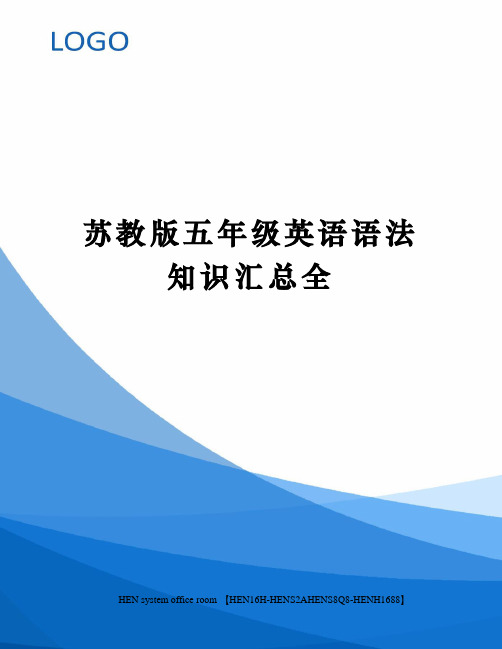
苏教版五年级英语语法知识汇总全HEN system office room 【HEN16H-HENS2AHENS8Q8-HENH1688】英语语法知识汇总-五年级2、人称代词和物主代词人称代词:有主格和宾格之分。
一般动词前用主格,动词后用宾格。
3、指示代词4、冠词有a、an、the。
a和an的区别:an用于元音音素(一般就是元音字母a、e、i、o、u)前,a用于辅音音素前。
二、否定句:be动词(am、is、are)+not、情态动词can+ not、助动词(do、does) + not如何将一个肯定的陈述句改为否定句:1、看句中有无be动词,如有,直接在be动词后+ not。
2、看句中有无情态动词,如有,直接在情态动词后+ not。
3、如上述二者都没有,就应用助动词+ not。
分四个步骤:(1)肯定陈述句中本来是没有助动词的,要加上去,位置在主语(某人或某物)后,动词前。
(2)确定助动词用do、does,根据句中动词,动词是原形的助动词就用do,动词是第三人称单数的助动词就用does,(3)在助动词后加not。
(4)原句中动词假如发生变化就要恢复成原形。
强调一点,有some的要考虑是否要用any。
三、一般疑问句。
如何将一个肯定的陈述句改为一般疑问句:1、看句中有无be动词,如有,把be动词提到句首即可。
2、看句中有无情态动词,如有,把情态动词提到句首即可。
3、如上述二者都没有,就应把助动提到句首。
分四个步骤:(1)肯定陈述句中本来是没有助动词的,要加上去,位置在主语(某人或某物)后,动词前。
I do like you.(2)确定助动词用do还是does,根据句中动词,动词是原形的助动词就用do,动词是第三人称单数的助动词就用does He does like you. (3)把助动词后提到句首。
Does he like you? (4)原句中动词假如发生变化就要恢复成原形。
强调一点,有some的要考虑是否要用any。
苏教版五年级(上)英语语法知识汇总
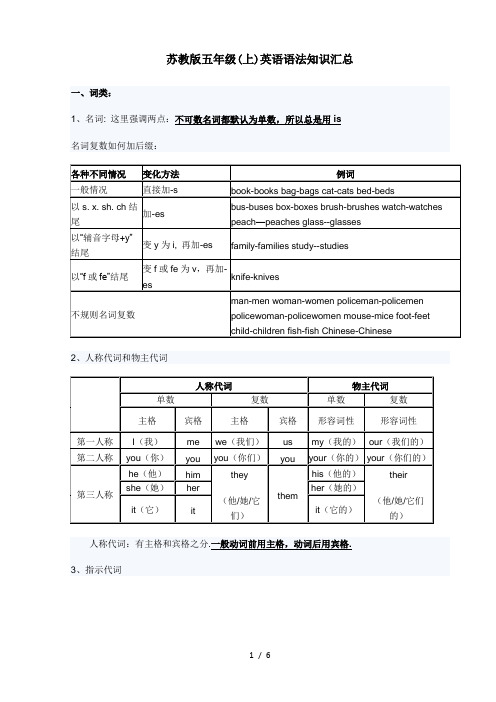
苏教版五年级(上)英语语法知识汇总一、词类:1、名词: 这里强调两点:不可数名词都默认为单数,所以总是用is 名词复数如何加后缀:2、人称代词和物主代词人称代词:有主格和宾格之分.一般动词前用主格,动词后用宾格.3、指示代词4、冠词有a、an、the.a和an的区别:an用于元音音素(一般就是元音字母a、e、i、o、u)前,a用于辅音音素前.二、否定句:●be动词(am、is、are)+not、●情态动词can+ not、●助动词(do、does)+ not如何将一个肯定的陈述句改为否定句:1、看句中有无be动词,如有,直接在be动词后+ not.2、看句中有无情态动词,如有,直接在情态动词后+ not.3、如上述二者都没有,就应用助动词+ not.分四个步骤:➢肯定陈述句中本来是没有助动词的,要加上去,位置在主语(某人或某物)后,动词前➢确定助动词用do、does,根据句中动词,动词是原形的助动词就用do,动词是第三人称单数的助动词就用does,➢在助动词后加not.➢原句中动词假如发生变化就要恢复成原形.强调一点,有some的要考虑是否要用any.三、一般疑问句.如何将一个肯定的陈述句改为一般疑问句:1、看句中有无be动词,如有,把be动词提到句首即可.2、看句中有无情态动词,如有,把情态动词提到句首即可.3、如上述二者都没有,就应把助动提到句首.分四个步骤:➢肯定陈述句中本来是没有助动词的,要加上去,位置在主语(某人或某物)后,动词前.➢确定助动词用do还是does,根据句中动词,动词是原形的助动词就用do,动词是第三人称单数的助动词就用does➢把助动词后提到句首.➢原句中动词假如发生变化就要恢复成原形.强调一点,有some的要考虑是否要用any.四、特殊疑问句.表示疑问,有疑问词(在开头),回答有很多种可能.常用疑问词:五、时态1、一般现在时:●一般现在时中的be动词:一般用原形:am is are①am用于第一人称单数(I);②is用于第三人称单数(he she it和其他人名或称谓,如:Ben his sister等);③are用于第二人称单数(you)和所有复数(包括第一人称复数we、第二人称复数you;第三人称复数they和其他复数,如the children 、his parents等).●一般现在时中的动词:第一种情况:主语是第三人称单数(he she it 和其他,如Helen 、her cousin等),动词后一般加s或es.第二种情况:主语不是第三人称单数,动词都用原形.一般现在时判断依据(如何判断一个句子是一般现在时):△be动词是am、is、are △动词用原形或加s、es△没有时间状语或有usually、often、everyday、sometimes等不是具体的时间2、现在进行时(1)构成形式:Be动词+动词的ing形式这里强调一点,两者缺少其中任何一种都不可以构成现在进行时.(2)现在进行时表示动作正在进行或事情正在发生.(3)有用的依据:一个句子中既有be动词,又有动词,且动词加了ing ←→ 该句是现在进行时(4)句中往往有now、look、listen等词.动词现在分词的变化见下表:同音词:too---two----to ;buy---by ;I---eye;four----forthere----their ;right----write ;sun----son ;no----knowhere---hear ;who’s----whose近义词:many---a lot of 或者lots of;large----big ;desk----table;photo---picture;lamp----light;like----love;ill---sick反义词或对应词:old----new ;;big----small;open----close;black----white;here----there完整形式:let’s=let us(让我们) I’d=I would can’t=can not I’m=I am词性变换:one(序数词) first monkey(复数)monkeys skiing(原形)skiis(复数)are families(单数)family make(现在分词)makingwe are(缩略形式)we’re do(第三人称单数)does have(第三人称单数)hasphoto(复数)photos fat(反义词)thin★做题目时一定要记住:1.can+动词原形2.like+动词ing3.like+名词复数4.play+足球类play the +乐器类5.how many +名词复数6.would like +to+动词原形;want+to+动词原形7.let's+动词原形8.现在进行时:be(am,is,are)+动词ing9.动词第三人称单数形式10.11.12.13.。
苏教版五年级(上)英语语法知识汇总

苏教版五年级(上)英语语法知识汇总一、词类:1、名词: 这里强调两点:不可数名词都默认为单数,所以总是用is名词复数如何加后缀:2、人称代词和物主代词人称代词:有主格和宾格之分。
一般动词前用主格,动词后用宾格。
3、指示代词4、冠词有a、an、the。
a和an的区别:an用于元音音素(一般就是元音字母a、e、i、o、u)前,a用于辅音音素前。
二、否定句:●be动词(am、is、are)+not、●情态动词can+ not、●助动词(do、does)+ not如何将一个肯定的陈述句改为否定句:1、看句中有无be动词,如有,直接在be动词后+ not。
2、看句中有无情态动词,如有,直接在情态动词后+ not。
3、如上述二者都没有,就应用助动词+ not。
分四个步骤:➢肯定陈述句中本来是没有助动词的,要加上去,位置在主语(某人或某物)后,动词前➢确定助动词用do、does,根据句中动词,动词是原形的助动词就用do,动词是第三人称单数的助动词就用does,➢在助动词后加not。
➢原句中动词假如发生变化就要恢复成原形。
强调一点,有some的要考虑是否要用any。
三、一般疑问句。
如何将一个肯定的陈述句改为一般疑问句:1、看句中有无be动词,如有,把be动词提到句首即可。
2、看句中有无情态动词,如有,把情态动词提到句首即可。
3、如上述二者都没有,就应把助动提到句首。
分四个步骤:➢肯定陈述句中本来是没有助动词的,要加上去,位置在主语(某人或某物)后,动词前。
➢确定助动词用do还是does,根据句中动词,动词是原形的助动词就用do,动词是第三人称单数的助动词就用does➢把助动词后提到句首。
➢原句中动词假如发生变化就要恢复成原形。
强调一点,有some的要考虑是否要用any。
四、特殊疑问句。
表示疑问,有疑问词(在开头),回答有很多种可能。
常用疑问词:五、时态1、一般现在时:●一般现在时中的be动词:一般用原形:am is are①am用于第一人称单数(I);②is用于第三人称单数(he she it和其他人名或称谓,如:Ben his sister等);③are用于第二人称单数(you)和所有复数(包括第一人称复数we、第二人称复数you;第三人称复数they和其他复数,如the children 、his parents等)。
最新苏教版五年级语法及练习.docx

苏教版五年级语法及练习There be句型与have, hasThere be句型与have, has的区别1、there be句型与have(has)的区别:there be表示在某地有某物(或人);have(has)表示某人拥有某物.There be句型是客观存在的“有”, 表示在某地有某物(或人), 是一种存在关系.eg:There is a book on the desk.Have/has指的是主观上的“拥有, 持有” , 表示某人拥有某物, 是一种所属关系 .Eg: I have a book.2、在 there be 句型中 ,there 只起到引导作用 , 并无实际意义 . 句中真正主语是谓语动词 be 后面的名词 .Be 动词有人称 , 数和时态的变化:主语是单数 ,be 动词用 is ; 主语是复数 ,be 动词用 are .3.如有几件物品 ,be 动词根据最近 be 动词的那个名词决定(就近原则) .4、there be 句型的否定句在be 动词后加 not ,一般疑问句把be 动词调到句首 , 肯定回答: Yes, there is/are.否定回答:No,there is n’ t/aren’t.5、some 和 any 在 there be 句型中的运用: some 用于肯定句 ,any用于否定句或疑问句.6、and 和 or在there be句型中的运用:and 用于肯定句 , or用于否定句或疑问句.7、针对数量提问的特殊疑问句的基本结构是:How many +名词复数+ are there +介词短语?How much + 不可数名词+ is there +介词短语?8、针对主语提问的特殊疑问句的基本结构是:What ’ s +介词短语?练习: Fill in the blank with“ have,has” or“there is , there are”1.I________a good father and a good mother.2.____________a telephone on the desk.3.He_________a tape-recorder.4._____________a basketball in the playground.5.She__________some dresses.6.They___________a nice garden.7.What do you___________?8.______________a reading-room in the building?9.What does Mike___________?10.______________any books in the bookcase?11.My father_________a story-book.13._______________any flowers in the vase?14.How many students____________in the classroom?15.My parents___________some nice pictures.16._____________some soup on the table.17.______________a map of the world on the wall.18.David__________a telescope.19.David ’s friends___________some tents.20.______________many children on the hill.Fill in the blank with“ have, has”1.I_________ a nice puppet.2.He_________a good friend.3.They__________ some masks.4.We___________some flowers.5.She___________ a duck.6.My father____________ a new bike.7.Her mother___________a vase.8.Our teacher_________ an English book.9.Our teachers___________a basketball.10.Their parents___________some blankets11.Nancy_________many skirts.12.David__________some jackets.13.My friends__________a football.14.What do you__________?15.What does Mike__________?16.What do your friends___________?17.What does Helen___________?18.His brother________a basketball.19.Her sister_________a nice doll.20.Miss Li__________an English book.改为否定句:There is some milk in the bottle._______________________________________________________________________________填 be 动词 .There _____ a book and two pens on the desk.There _____ two pens and a book on the desk.Be 动词Be 动词是动词的一种,其中“ am,is,are”用于一般现在时.Be 动词在句中不能单独作谓语,多与后面的名词或形容词等构成系表结构.Be 动词的使用口诀:我用 am,你用 are,is 跟着他她它 .单数 is,复数 are.用 be 动词填空 .1.This bed _____ too soft.2.Where _____ the cakes?3.There ______ three beds and a chair in the room.4.There ______ a book and a pen on the chair.5.My sister and I _______ in the same class.6.Two and five _____ seven.7.There ______ a lot of sheep on the farm.8. Who _____ singing in the room?Liuhua is.9.There _____ some water in the bottle.10.He can _____ a teacher.法及 4 一般在一般在基本用法介一般在的概念表示常、反复生的作或在存在的状.一般在的志:率副:Always, usually, often, sometimes,状:Every ⋯一般在的构成1. be:主+be(am,is,are)+其它.如:I am a boy.我是一个男孩.2.行:主 +行 (+ 其它 ). 如: We study English. 我学英 .当主第三人称数(he, she,it), 要在后加 "-s" 或 "-es".如:Mary likes Chinese. 喜 .一般在的化1.否定句:有 be,be 后 +not有情 , 情后 +not有 , 借助do/does 后 +not2.一般疑句:有 be ,be 提前有情 ,情提前有 , 借助 do/does 提前3.特殊疑问句:特殊疑问词+一般疑问句一般现在时用法专练 :一、用括号内动词的适当形式填空.1.He often ________(have) dinner at home.2.Daniel and Tommy _______(be) in Class One.3.We _______(not watch) TV on Monday.4.Nick _______(not go) to the zoo on Sunday.5.______ they ________(like) the World Cup?6.What _______they often _______(do) on Saturdays?7._______ your parents _______(read) newspapers every day?8.The girl _______(teach) us English on Sundays.9.She and I ________(take) a walk together every evening.10.There ________(be) some water in the bottle.11.Mike _______(like) cooking.12.They _______(have) the same hobby.13.My aunt _______(look) after her baby carefully.14.You always _______(do) your homework well.15. I _______(be) ill. I’m staying in bed.16.She _______(go) to school from Monday to Friday.17.Liu Tao _______(do) not like PE.18.The child often _______(watch) TV in the evening.19.Su Hai and Su Yang _______(have) eight lessons this term.20.-What day _______(be) it today?-It’s Saturday.二、按照要求改写句子.1. Daniel watches TV every evening.(改为否定句)__________________________________________________________________ 2. I do my homework every day.(改为一般疑问句,作否定回答)__________________________________________________________________ 3.She likes milk.(改为一般疑问句,作肯定回答)__________________________________________________________________ ( 改为一般疑问句 , 作否定回答 )__________________________________________________________________ 5. We go to school every morning.(改为否定句)_________________________________________________________________ 6. He speaks English very well.(改为否定句)__________________________________________________________________7. I like taking photos in the park.(对划线部分提问)__________________________________________________________________( 对划线部分提问 )__________________________________________________________________9. She is always a good student.(改为一般疑问句, 作否定回答 )__________________________________________________________________10. Simon and Daniel like going skating.(改为否定句)__________________________________________________________________三、改错 ( 划出错误的地方 , 将正确的写在横线上)1.Is your brother speak English? ________________________________2.Does he likes going fishing? __________________________________3.He likes play games after class. ______________________________4.Mr. Wu teachs us English. _____________________________________5.She don ’ t do her homework on Sundays. ________________________动词三单的变化规则1.一般情况下 , 直接加 -s, 如: cook-cooks, milk-milks2.以 s. x. sh. ch. o 结尾 , 加 -es, 如: guess-guesses, wash-washes, watch-watches, go-goes3.以“辅音字母 +y ”结尾 , 变 y 为 i, 再加 -es, 如: study-studies 练习 : 写出下列动词的第三人称单数drink ________ go _______stay ________ make ________look _________ have_______ pass_______carry ________study_______brush________ do_________ teach_______wash_______二、用括号内动词的适当形式填空.1.He often ________(have) dinner at home.2.Daniel and Tommy _______(be) in Class One.3.We _______(not watch) TV on Monday.4.Nick _______(not go) to the zoo on Sunday.5.______ they ________(like) the World Cup?6.What _______they often _______(do) on Saturdays?7._______ your parents _______(read) newspapers every day?8.The girl _______(teach) us English on Sundays.9.She and I ________(take) a walk together every evening.10.There ________(be) some water in the bottle.11.Mike _______(like) cooking.12.They _______(have) the same hobby.13.My aunt _______(look) after her baby carefully.14.You always _______(do) your homework well.15. I _______(be) ill. I’m staying in bed.16.She _______(go) to school from Monday to Friday.17.Liu Tao _______(do) not like PE.18.The child often _______(watch) TV in the evening.19.Su Hai and Su Yang _______(have) eight lessons this term.20.-What day _______(be) it today?- It ’s Saturday第三人称单数主语1.人称代词 he,she,it2.单个人名 , 地名或称呼3.单数可数名词或“ this 、 that+ 可数名词单数”4.不定代词 someone,somebody,nobody,everything,something 及指示代词this,that名词一.名词分类 .名词分为可数名词和不可数名词.可数名词有单数和复数之分.二.可数名词复数规则1.一般情况下 , 直接加 -s, 如: book-books, bag-bags, cat-cats, bed-beds2.以 s. x. sh. Ch和部分O结尾,加-es,如:bus-buses, box-boxes, watch-watches Photo-photos,3.以“辅音字母 +y”结尾, 变 y 为i, 再加-es, 如:family-families,strawberry-strawberries 4.以“ f 或 fe ”结尾 , 变 f 或 fe 为 v,再加-es,如:knife-knives5.单复同型:fish-fish, deer-deer, sheep-sheep, people-people, Chinese-Chinese, Japanese-Japanese6.不规则名词复数:改变中间的原因字母:man-men, woman-women, policeman-policemen, policewoman-policewomen, foot-feet,tooth-teeth词尾加 -en 或 -ren :child-children ,ox-oxen不规则: mouse-mice6/10不可数名词主要是物质名词和抽象名词. 不可数名词没有复数形式 , 也不能与 a,an 连用 .四.不可数名词量的表示方法1. 用 some, much, a little, a lot of, lots of等表示多少 .2.用量词表示:在表示“一”个数量概念时用 a cup of, a bottle of, a glass of等, 若要表达两个或两个以上得概念, 量词用复数 , 不可数不变 ,eg: two cups of tea练习:写出下列各词的复数 .I _________him _________this _______ her ______watch _______book_______ bus______ Chinese________ a cup of tea_______ house_______ child_______photo ________ diary ______day________foot________ dress________tooth______ sheep ______ box_______strawberry __________ thief_______ yo-yo ______ peach______sandwich______man______ woman_______paper_______people________单选 .1.He does many _____.A.workB.jobC.worksD.jobs名词所有格名词所有格一般是在名词后面加上’s, 意为“ ...的” ,表示所属关系.1.一般情况下 , 在单词词尾 +’ s2.以 s 结尾的复数名词 , 在词尾 +‘3.不以 s 结尾的不规则复数名词 , 在词尾 +’ s4.若表示两者各自拥有的东西 , 在两个名词后面都 +’ s;若表示两者共同拥有一个东西 , 则只在后面的名词后 +’s5.一些表示日期 , 时间 , 距离 , 国家名称的无生命的名词 , 也可加’ s6.如果’ s 后面的词是商店 , 住宅等地点 , 后面的名词要省略 .感叹句感叹句通常由what 或 how 引导 ,用以表示赞美、惊叹、喜悦等感情,句末一般用感叹号.一.感叹句句型:1. What +a (an)+ 形容词 +可数名词单数(+主语 +动词 +!What+ 形容词 +可数名词复数或可数名词(+主语 +其他)!Eg: What a beautiful girl (she is)!What beautiful girls (they are)!2. how+ 形容词 /副词( +主语 +动词)!How beautiful (the girl is)!二.感叹句口诀:陈改感叹并不难,what 或 how 放最前;主在句末,它省略也常.三.“一断 ,二加 ,三位”法 .一断:在后面断开,使句子分两部分.Eg: He is / a good teacher.二加:在第二部分前加上how 或 what.Eg : He is /what a good teacher.三位:把第一部分和第二部分位置互,句号改成感号.Eg: What a good teacher he is!将下列句子改感句.1.The ship is big._______________________________________________________________________ 2.This film is very good._______________________________________________________________________ 3.He works very hard._______________________________________________________________________ 4.It is a nice book._______ ________ nice present it is!5.It is a funny day today._______ _________ sunny day it is day!6.She plays basketball well._______ _________ she plays basketball!Too 的用法1.表示“也”的意思,用于句末 .Eg: Nice to meet you .Nice to meet you ,too.2.表示“太” ,程度 .3.有关 too 的短:“ much too”表示“太⋯ .”=too“too much+ 不可数名”表示“太多⋯ ..”=much“ too many+ 可数名复数” 表示“太多⋯ ..=many“ too⋯ to⋯”表示“太 ...而不能 ...”too 与 alsotoo 与 also 都有也的意思 ,两者都用于肯定句中,但位置不同 .Too 常用于句末 ,口气 ,多用于口Also 常用于句中 ,,口气重 ,多用于面.基数和序数基数:表示数目多少的数.序数:表示先后序的数.序数前要加the.基数序数口:基序 ,有律 ,尾加上th;一二三 ,特殊 ,尾字母tdd;八去 t,九去 e,f 要把 ve 替 .Ty 要把 y i,住 th 前有个 e.若是遇几十几,只个位九可以.用所给数词填空.1.Sunday is the _____ day of a week. (one)2.There are _______________ hours in a day. (twenty –four)3.His sister is _______ years old.(ten)4.Ten and five is ______.(five)5.Teachers’Day is on the ______ of September.(ten)Some 和 anySome 和 any 都有“一些”的意思,既修饰可数名词复数,又修饰不可数名词. Some 和 any 的用法口诀:肯定句中用some,否定、疑问用any.但有两点特殊记:若表邀请或请求,疑问也要用some.若表“任何一个“接单数,肯定也要用any.Let 型祈使句Let+宾语 +动词原形 +其他( let sb. do sth.)1.表示“建议 ,劝导”2.表示“请求 ,命令”表示到做某事的时间了It ’s time for+ 名词It ‘s time to + 动词句子类型1.肯定句变否定句:1)有 be 动词 ,be 动词后加not2)有情态动词 ,情态动词后加not3)有实义动词 ,借助动词do 或 does,再加 not2.肯定句变一般疑问句:1)有 be 动词 ,be 动词提前2)有情态动词 ,情态动词提前3)有实义动词 ,借助动词do 或 does,把 do 或 does 提前3.特殊疑问句特殊疑问词 +一般疑问句喜欢做某事Like doing动词 ing 形式的变化规则:1)大部分动词直接在词尾+ing2)以不发音的字母 e 结尾的词 ,先去 e,再加 ing3)以单个辅音字母结尾的重读闭音节动词,先双写末尾的福音字母,再加 ingLike doing和like to doLike doing 和 like to do都表示“喜做某事”Like doing 表示的是好或者常性的行Like to do 表示的是某一次的具体的行.情 can 的用法Can 的用法口:“我”是情can,若表能力我承担;不管主怎么,can 的模都不;原形站后,一般疑can 提前;否定 can 后 not 添 ,学好 can 很 .表达擅做某事Be good at+ing/ 名 /代1.what +do/does +主 +do ?2.what +is/are + ⋯’s(物主代 )+job?Help 的用法1. Help sb. with sth. 帮助某人做某事2. Help sb. do sth. 帮助某人做某事某人怎么了What’s wrong with..?=what ’s the matter?人多大了How old+be+ 主?Look out 小心Wait a minute 等一下Don’tworry. 担心First, ⋯next ⋯ then⋯ finally ⋯Merry Christmas!10/10。
最新苏教版五年级英语语法复习重点.docx
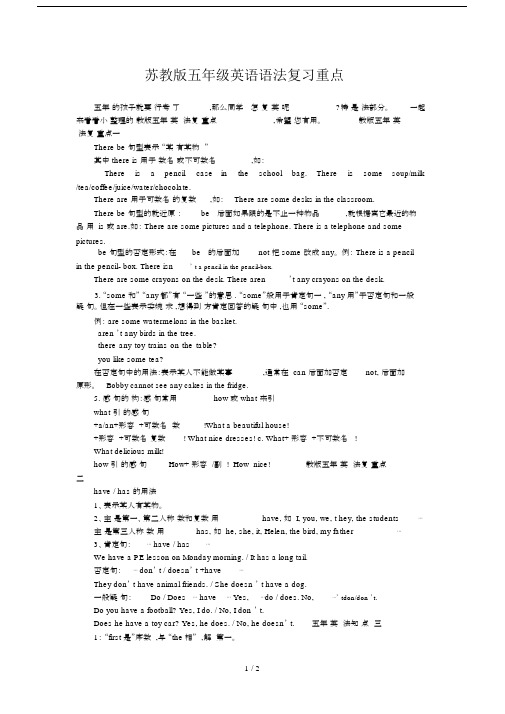
苏教版五年级英语语法复习重点五年的孩子就要行考了,那么同学怎复英呢?特是法部分。
一起来看看小整理的教版五年英法复重点,希望您有用。
教版五年英法复重点一There be 句型表示“某有某物”其中 there is 用于数名或不可数名,如:There is a pencil case in the school bag. There is some soup/milk /tea/coffee/juice/water/chocolate.There are 用于可数名的复数,如:There are some desks in the classroom.There be 句型的就近原:be 后面如果跟的是不止一种物品,就根据离它最近的物品用 is 或 are.如: There are some pictures and a telephone. There is a telephone and somepictures.be 句型的否定形式:在be 的后面加not 把 some 改成 any。
例: There is a pencilin the pencil- box. There isn’ t a pencil in the pencil-box.There are some crayons on the desk. There aren’t any crayons on the desk.3.“some和”“any都”有“一些”的意思 . “some”般用于肯定句一 , “any用”于否定句和一般疑句。
但在一些表示委婉求 ,想得到方肯定回答的疑句中 ,也用“some”.例: are some watermelons in the basket.aren ’t any birds in the tree.there any toy trains on the table?you like some tea?在否定句中的用法:表示某人不能做某事,通常在 can 后面加否定not, 后面加原形。
苏教版五年级英语短语与语法汇总(K12教育文档)

苏教版五年级英语短语与语法汇总(word版可编辑修改)编辑整理:尊敬的读者朋友们:这里是精品文档编辑中心,本文档内容是由我和我的同事精心编辑整理后发布的,发布之前我们对文中内容进行仔细校对,但是难免会有疏漏的地方,但是任然希望(苏教版五年级英语短语与语法汇总(word版可编辑修改))的内容能够给您的工作和学习带来便利。
同时也真诚的希望收到您的建议和反馈,这将是我们进步的源泉,前进的动力。
本文可编辑可修改,如果觉得对您有帮助请收藏以便随时查阅,最后祝您生活愉快业绩进步,以下为苏教版五年级英语短语与语法汇总(word版可编辑修改)的全部内容。
Unit 1 Godilocks and the three bearsin the forest 在树林里 a beautiful house一座漂亮的房子in the house在房子里 hungry and thirsty又饿又渴some soup一些汤on the table在(饭)桌子上面too cold / too hot太冷/ 太热just right正合适,正好 three beds三张床in the room在房间里 too hard / too soft太硬/ 太软three bears三只熊 some toy cars 一些玩具汽车in the kitchen在厨房里 find their cousin发现他们的表弟in the living room 在客厅里 This…is too…这(个)……太……in the fridge 在冰箱里 on the chair 在椅子上面under the table 在饭桌下面in front of me/ her在我/她的前面beside the door在门旁边 between the two chairs在两把椅子中间these words 这些单词 my uncle我叔叔(舅舅/……)have a cold 得了感冒 put on…穿上……your coats 你(你们)的大衣you two 你们俩个 in China 在中国have(eat )some cakes吃一些蛋糕 in the glass在玻璃杯里in the tree 在树上 a glass of milk 一杯牛奶★there’s= there is I’m = I am四会句型:There be( is ,are )…in / on / under / behind / beside / between / in f ront of / …在“某个地方”有(表示存在有) “某物”Unit 2 A new studenta new student一名新学生 show…around…带……参观How many classrooms多少间教室 the first floor一楼the second floor二楼the third floor三楼in our school 在我们学校 our classroom 我们的教室on the second floor 在二楼computer room 电脑室on the third floor 在三楼 music room 音乐室on the first floor 在一楼table tennis room 乒乓球室have a look 看一看go and have a look 去看一看an art room一间美术室in the(at)school 在学校in her new school在她的新学校drink some nice juice喝些可口的果汁go to the cinema 去电影院 on the wing 在秋千上push me 推我so heavy很重too high太高great fun 很有趣It’s time for…(名词)是…。
苏教版五年级英语语法知识汇总全
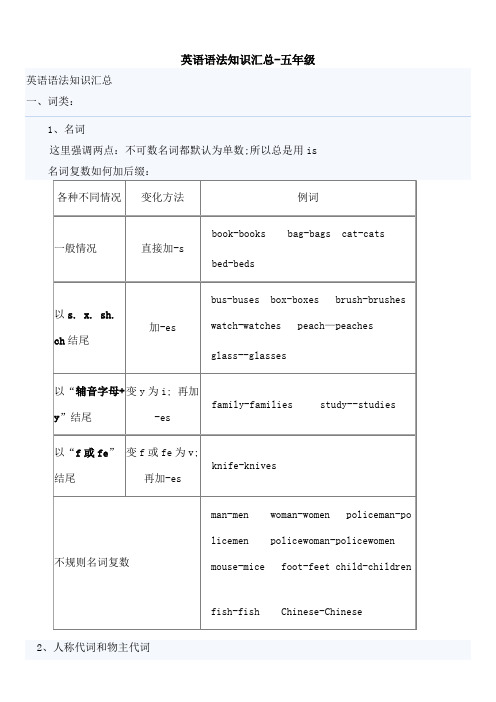
英语语法知识汇总-五年级2、人称代词和物主代词人称代词:有主格和宾格之分..一般动词前用主格;动词后用宾格..3、指示代词4、冠词有a、an、the..a和an的区别:an用于元音音素一般就是元音字母a、e、i、o、u前;a用于辅音音素前..二、否定句:be动词am、is、are+not、情态动词can+ not、助动词do、does + not如何将一个肯定的陈述句改为否定句:1、看句中有无be动词;如有;直接在be动词后+ not..2、看句中有无情态动词;如有;直接在情态动词后+ not..3、如上述二者都没有;就应用助动词+ not..分四个步骤:1肯定陈述句中本来是没有助动词的;要加上去;位置在主语某人或某物后;动词前..2确定助动词用do、does;根据句中动词;动词是原形的助动词就用do;动词是第三人称单数的助动词就用does;3在助动词后加not..4原句中动词假如发生变化就要恢复成原形..强调一点;有some的要考虑是否要用any..三、一般疑问句..如何将一个肯定的陈述句改为一般疑问句:1、看句中有无be动词;如有;把be动词提到句首即可..2、看句中有无情态动词;如有;把情态动词提到句首即可..3、如上述二者都没有;就应把助动提到句首..分四个步骤:1肯定陈述句中本来是没有助动词的;要加上去;位置在主语某人或某物后;动词前..I do like you.2确定助动词用do还是does;根据句中动词;动词是原形的助动词就用do;动词是第三人称单数的助动词就用doesHe does like you.3把助动词后提到句首..Does he like you4原句中动词假如发生变化就要恢复成原形..强调一点;有some的要考虑是否要用any..四、特殊疑问句..表示疑问;有疑问词在开头;回答有很多种可能..常用疑问词:五、时态1、一般现在时:表示某动作或者某状态是经常发生的事情;或者是自然规律..•主语+be动词am; is ; are•主语+动词原形注意动词要根据主语变三单1一般现在时中的be动词:一般用原形:am is aream用于第一人称单数I;is用于第三人称单数he she it和其他人名或称谓;如:Ben his sister等;are用于第二人称单数you和所有复数包括第一人称复数we、第二人称复数you;第三人称复数they和其他复数;如the children 、 his parents等..2一般现在时中的动词:第一种情况:主语是第三人称单数he she it 和其他;如Helen 、her cousin 等;动词后一般加s或es..第二种情况:主语不是第三人称单数;动词都用原形..4一般现在时判断依据如何判断一个句子是一般现在时:△be动词是am、is、are △动词用原形或加s、es△没有时间状语或有usually、often、everyday、sometimes等不是具体的时间2、现在进行时1构成形式:Be动词+动词的ing形式这里强调一点;两者缺少其中任何一种都不可以构成现在进行时..2现在进行时表示动作正在进行或事情正在发生..3有用的依据:一个句子中既有be动词;又有动词;且动词加了ing ←→该句是现在进行时4句中往往有now、look、listen等词..动词现在分词的变化见下表:同音词: too---two----to buy---by I---eye four----for there----their right----write sun----son no----knowhere---hear who’s----whose近义词:many----a lot of / lots of large----big desk----table photo---picture lamp----light like----love反义词或对应词:old----new go----come big----smallopen----close black----white here----there完整形式:let’s=let us让我们 I’d=I wouldcan’t=can not I’m=I am词性变换:one序数词 first monkey复数monkeys skiing原形skiis复数are families单数family make现在分词makingwe are缩略形式we’re do第三人称单数does have第三人称单数hasphoto复数photos fat反义词thin★做题目时一定要记住:1.can+动词原形2.like+动词ing3.like+名词复数4.play+足球类 play the +乐器类5.how many +名词复数6.would like +to+动词原形7.let's+动词原形8.现在进行时:beam;is;are+动词ing9.动词第三人称单数形式英语音标及字母组合对照元音:1 i: 字母组合:ee ea e ie ei eythree tree green sheep meet beef see seekeat tea meat leave lead teacher team mean speak clean pleasehe she mepiece receive ceiling2 I 发音字母 i y e ui u asit picture it is list six mix fix fit pig big build missmyth many twenty happy dictionarydefect decide delicious3 发音字母 abag hand and ant happy hat map mad bad black back glad flag shall man4 e 字母组合 ea e a ue;u;ie;ai;ei;ayhead bread pleasureelephant electric remember sell shell lesson better bed desk hotel yesmany any5 ε: 字母组合ir ur ear er orgirl shirt skirt thirty thirteen third birdturn burn murder nurse turtle Thursday burgerlearn earn earth heardterm her nerd servework worm work world6 ε字母组合 er or ou ar o a e uteacher leader remember player speaker farmer powderdoctor actor mayor author tractordelicious gracious pleasurefamiliar collar dollartogether tomorrow today shallop lesson Washington control polite around account ago elephant manta banana Canada Japan chinamen listenfamulus Saturday7 a: 字母组合 ar acar farm card arm gardenfast class last glass plant aunt calm8 发音字母 u o ou ooup supper lunch fun gun hunt cup buscome mother dose brother love abovetrouble rough flourishblood flood9 : 字母组合 al or au our arsmall wall talk tall hall ball call walkshort more lord horse for forty sport door floor storeauthor caught autumnfour mourn court boughtwarm quarrel quarter10 发音字母 o a ouhot lost lot fox box mop hop loss collar notwant wash watch11 u: 字母组合 oo o ufood moon room gloom broom doom goose toothshoe do twotrue truth blue full prude12 u 字母组合 oo ou u olook good foot book woodshould couldput full bull pull pushwoman wolf13 ei 发音字母 a ay ea ai eyname cake late gate plane Aprilplay say may waygreat breakrain paint plainthey grey14 ai 发音字母 i ybike fine find die nine light night highmy try fly eye15 au 字母组合 ou owhouse out flour ground account count sound loud around mouse flower down now cow how town16 εu 发音字母 o ow oahome cold go no phone host ghostknow low below grow blow show flowboat coat goal17 字母组合oy oiboy toy joyoil soil voice choice18 iε字母组合 eer earbeer deerear nearhere fierce idea19 e 字母组合ear air erepear bearchair air fairthere where care20 uε au 字母组合our owerhour tourflower shower。
苏教版小学五年级英语语法(完整资料).doc

【最新整理,下载后即可编辑】五年级英语语法知识汇总一、词类:1、名词这里强调两点:不可数名词都默认为单数,所以总是用is 名词复数如何加后缀:3、指示代词有a、an、the。
a和an的区别:an用于元音音素(一般就是元音字母a、e、i、o、u)前,a用于辅音音素前。
二、否定句:be动词(am、is、are)+not、情态动词can+ not、助动词(do、does)+ not如何将一个肯定的陈述句改为否定句:1、看句中有无be动词,如有,直接在be动词后+ not。
2、看句中有无情态动词,如有,直接在情态动词后+ not。
3、如上述二者都没有,就应用助动词+ not。
分四个步骤:(1)肯定陈述句中本来是没有助动词的,要加上去,位置在主语(某人或某物)后,动词前。
(2)确定助动词用do、does,根据句中动词,动词是原形的助动词就用do,动词是第三人称单数的助动词就用does,(3)在助动词后加not。
(4)原句中动词假如发生变化就要恢复成原形。
强调一点,有some的要考虑是否要用any。
三、一般疑问句。
如何将一个肯定的陈述句改为一般疑问句:1、看句中有无be动词,如有,把be动词提到句首即可。
2、看句中有无情态动词,如有,把情态动词提到句首即可。
3、如上述二者都没有,就应把助动提到句首。
分四个步骤:(1)肯定陈述句中本来是没有助动词的,要加上去,位置在主语(某人或某物)后,动词前。
(2)确定助动词用do还是does,根据句中动词,动词是原形的助动词就用do,动词是第三人称单数的助动词就用does(3)把助动词后提到句首。
(4)原句中动词假如发生变化就要恢复成原形。
强调一点,有some的要考虑是否要用any。
四、特殊疑问句。
表示疑问,有疑问词(在开头),回答有很多种可能。
常用疑问词:五、时态1、一般现在时(1)一般现在时中的be动词:一般用原形:am is aream用于第一人称单数(I);is用于第三人称单数(he she it和其他人名或称谓,如:Ben his sister等);are用于第二人称单数(you)和所有复数(包括第一人称复数we、第二人称复数you;第三人称复数they和其他复数,如the children 、his parents等)。
苏教版五年级英语短语与语法汇总

Unit 1 Godilocks and the three bearsin the forest 在树林里 a beautiful house一座漂亮的房子in the house在房子里hungry and thirsty又饿又渴some soup一些汤on the table在(饭)桌子上面too cold / too hot太冷 / 太热just right正合适,正好three beds三张床in the room在房间里too hard / too soft太硬 / 太软three bears三只熊some toy cars 一些玩具汽车in the kitchen在厨房里find their cousin发现他们的表弟in the living room 在客厅里This…is too…这(个)……太……in the fridge 在冰箱里on the chair 在椅子上面under the table 在饭桌下面 in front of me/ her在我/她的前面beside the door在门旁边between the two chairs在两把椅子中间these words 这些单词my uncle我叔叔(舅舅/……)have a cold 得了感冒put on…穿上……your coats 你(你们)的大衣you two 你们俩个in China 在中国have( eat )some cakes吃一些蛋糕in the glass在玻璃杯里in the tree 在树上 a glass of milk 一杯牛奶★there’s= there is I’m = I am四会句型:There be( is , are )…in / on / under / behind / beside / between / in front of / …在“某个地方”有(表示存在有)“某物”Unit 2 A new studenta new student一名新学生show…around…带……参观How many classrooms多少间教室the first floor一楼the second floor二楼 the third floor三楼in our school 在我们学校our classroom 我们的教室on the third floor 在三楼music room 音乐室on the first floor 在一楼 table tennis room 乒乓球室have a look 看一看 go and have a look 去看一看an art room一间美术室 in the(at)school 在学校in her new school在她的新学校drink some nice juice喝些可口的果汁go to the cinema 去电影院on the wing 在秋千上push me 推我 so heavy很重 too high太高great fun 很有趣It’s time for…(名词)是…..的时候了。
- 1、下载文档前请自行甄别文档内容的完整性,平台不提供额外的编辑、内容补充、找答案等附加服务。
- 2、"仅部分预览"的文档,不可在线预览部分如存在完整性等问题,可反馈申请退款(可完整预览的文档不适用该条件!)。
- 3、如文档侵犯您的权益,请联系客服反馈,我们会尽快为您处理(人工客服工作时间:9:00-18:30)。
五年级英语语法知识汇总
一、词类:
1、名词
这里强调两点:不可数名词都默认为单数,所以总是用is
名词复数如何加后缀:
3、指示代词
有a、an、the。
a和an的区别:an用于元音音素(一般就是元音字母a、e、i、o、u)前,a 用于辅音音素前。
二、否定句:
be动词(am、is、are)+not、
情态动词can+ not、
助动词(do、does) + not
如何将一个肯定的陈述句改为否定句:
1、看句中有无be动词,如有,直接在be动词后+ not。
2、看句中有无情态动词,如有,直接在情态动词后+ not。
3、如上述二者都没有,就应用助动词+ not。
分四个步骤:
(1)肯定陈述句中本来是没有助动词的,要加上去,位置在主语(某人或某物)后,动词前。
(2)确定助动词用do、does,根据句中动词,动词是原形的助动词就用do,动词是第三人称单数的助动词就用does,
(3)在助动词后加not。
(4)原句中动词假如发生变化就要恢复成原形。
强调一点,有some的要考虑是否要用any。
三、一般疑问句。
如何将一个肯定的陈述句改为一般疑问句:
1、看句中有无be动词,如有,把be动词提到句首即可。
2、看句中有无情态动词,如有,把情态动词提到句首即可。
3、如上述二者都没有,就应把助动提到句首。
分四个步骤:
(1)肯定陈述句中本来是没有助动词的,要加上去,位置在主语(某人或某物)后,动词前。
(2)确定助动词用do还是does,根据句中动词,动词是原形的助动词就用do,动词是第三人称单数的助动词就用does
(3)把助动词后提到句首。
(4)原句中动词假如发生变化就要恢复成原形。
强调一点,有some的要考虑是否要用any。
四、特殊疑问句。
表示疑问,有疑问词(在开头),回答有很多种可能。
常用疑问词:
五、时态
1、一般现在时
(1)一般现在时中的be动词:
一般用原形:am is are
am用于第一人称单数(I);is用于第三人称单数(he she it和其他人名或称谓,如:Ben his sister等);are用于第二人称单数(you)和所有复数(包括第一人称复数we、第二人称复数you;第三人称复数they和其他复数,如the children 、 his parents等)。
(2)一般现在时中的动词:
第一种情况:主语是第三人称单数(he she it 和其他,如Helen 、her cousin 等),动词后一般加s或es。
第二种情况:主语不是第三人称单数,动词都用原形。
(4)一般现在时判断依据(如何判断一个句子是一般现在时):
△be动词是am、is、are △动词用原形或加s、es
△没有时间状语或有usually、often、everyday、sometimes等不是具体的时间
2、现在进行时
(1)构成形式:Be动词+动词的ing形式
这里强调一点,两者缺少其中任何一种都不可以构成现在进行时。
(2)现在进行时表示动作正在进行或事情正在发生。
(3)有用的依据:一个句子中既有be动词,又有动词,且动词加了ing ←→该句是现在进行时
(4)句中往往有now、look、listen等词。
动词现在分词的变化见下表:
同音
词: too---two----to buy---by I---eye four----for
there----their right----write sun----son no----know
here---hear who’s----whose
近义词: many----a lot of / lots
of large----big desk----table
photo---picture lamp----light like----love
反义词或对应词:
old----new go----come big----small
open----close black----white here----ther e
完整形式:let’s=let us(让我们) I’d=I would can’t=can
not I’m=I am
词性变换:one(序数词) first monkey(复数)
monkeys skiing(原形)ski
is(复数)are families(单数)family make (现在分词)making
we are(缩略形式)we’re do(第三人称单
数)does have(第三人称单数)has
photo(复数)photos fat(反义词)thin。
